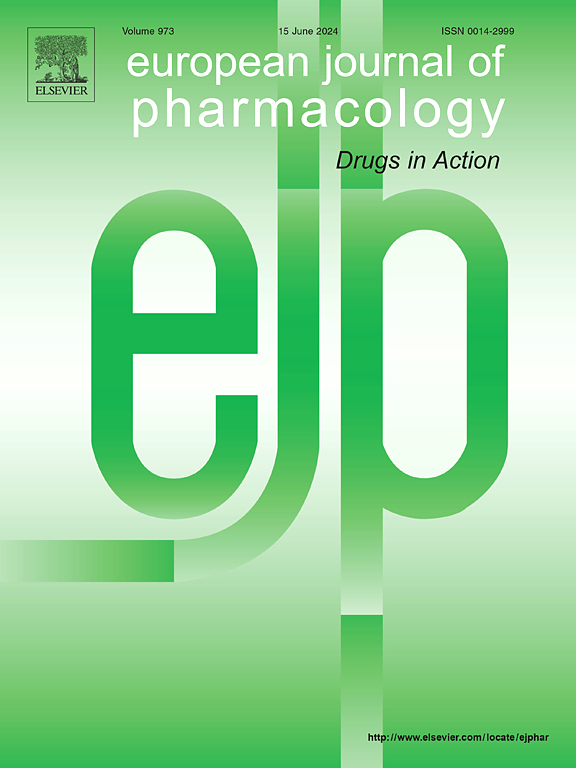Dipeptidyl peptidase 3 induces myocardial ischemia-reperfusion injury by mediating mitophagy and the intrinsic apoptotic pathway
IF 4.2
3区 医学
Q1 PHARMACOLOGY & PHARMACY
引用次数: 0
Abstract
Background
Dipeptidyl peptidase 3 (DPP3) is a zinc-dependent hydrolase that is regarded as a “myocardial inhibitor”. However, the role of DPP3 in myocardial ischemia-reperfusion injury (MIRI) remain to be investigated. The present study aimed to investigate the potential role of DPP3 in MIRI and elucidate the underlying mechanisms.
Methods
The AC16 cardiomyocyte cell line was used to investigate the interactions between DPP3 and its protein interactors, and assess its effects on the apoptosis of cardiomyocytes following oxygen glucose deprivation/reperfusion (OGD/R) treatment in vitro. An animal model of ischemia/reperfusion (I/R) injury was established using C57BL/6J mice for in vivo analyses. The role of DPP3 and the underlying mechanisms were investigated both in vitro and in vivo following DPP3 knockdown and overexpression.
Results
DPP3 interacted with Parkinson’s disease protein 7 (Park7), and DPP3 overexpression altered the expression levels of proteins related to the intrinsic apoptotic pathway and autophagy. This significantly downregulated the mitochondrial expression of cytochrome C, thereby exacerbating mitochondrial injury and increasing the rate of apoptosis following reperfusion. DPP3 knockdown reversed these effects; however, the simultaneous knockdown of DPP3 and Park7 did not confer the beneficial effects observed with DPP3 knockdown alone. DPP3 knockdown alleviated the extent of myocardial injury and improved cardiac function in the mouse model of I/R injury.
Conclusions
The study demonstrated that DPP3 mediates mitophagy and apoptosis in MIRI through its interaction with Park7. These findings have important implications, suggesting that targeting DPP3 and its associated signaling pathways may serve as a potential therapeutic strategy, and that the downregulation of DPP3 can potentially alleviate MIRI.
背景:二肽基肽酶 3(DPP3)是一种锌依赖性水解酶,被视为 "心肌抑制剂"。然而,DPP3 在心肌缺血再灌注损伤(MIRI)中的作用仍有待研究。本研究旨在探讨 DPP3 在 MIRI 中的潜在作用,并阐明其潜在机制:方法:使用 AC16 心肌细胞系研究 DPP3 与其蛋白相互作用体之间的相互作用,并评估其在体外氧葡萄糖剥夺/再灌注(OGD/R)处理后对心肌细胞凋亡的影响。利用 C57BL/6J 小鼠建立了缺血再灌注(I/R)损伤动物模型,用于体内分析。在体外和体内敲除和过表达 DPP3 后,研究了 DPP3 的作用及其内在机制:结果:DPP3与帕金森病蛋白7(Park7)相互作用,DPP3的过表达改变了内在凋亡途径和自噬相关蛋白的表达水平。这明显下调了线粒体中细胞色素C的表达,从而加剧了线粒体损伤并增加了再灌注后的细胞凋亡率。DPP3 基因敲除可逆转这些影响;然而,同时敲除 DPP3 和 Park7 并不能产生单独敲除 DPP3 所观察到的有益效果。在小鼠 I/R 损伤模型中,敲除 DPP3 可减轻心肌损伤程度并改善心脏功能:该研究表明,DPP3 通过与 Park7 相互作用,介导了 MIRI 中的有丝分裂和细胞凋亡。这些发现具有重要意义,表明靶向 DPP3 及其相关信号通路可能是一种潜在的治疗策略,下调 DPP3 有可能缓解 MIRI。
本文章由计算机程序翻译,如有差异,请以英文原文为准。
求助全文
约1分钟内获得全文
求助全文
来源期刊
CiteScore
9.00
自引率
0.00%
发文量
572
审稿时长
34 days
期刊介绍:
The European Journal of Pharmacology publishes research papers covering all aspects of experimental pharmacology with focus on the mechanism of action of structurally identified compounds affecting biological systems.
The scope includes:
Behavioural pharmacology
Neuropharmacology and analgesia
Cardiovascular pharmacology
Pulmonary, gastrointestinal and urogenital pharmacology
Endocrine pharmacology
Immunopharmacology and inflammation
Molecular and cellular pharmacology
Regenerative pharmacology
Biologicals and biotherapeutics
Translational pharmacology
Nutriceutical pharmacology.

 求助内容:
求助内容: 应助结果提醒方式:
应助结果提醒方式:


